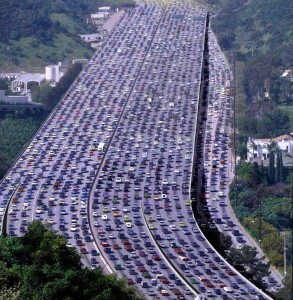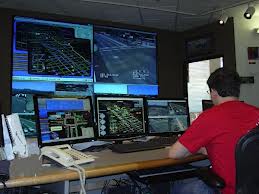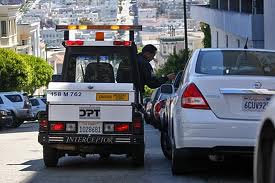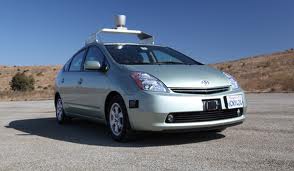Smarter Driving Key to Sustainable Transportation Planning
 In the popular mind, smarter, greener, and more sustainable transportation is generally equated with mega-projects like high speed rail, light rail, long tunnels for rail transport and, well, new subways and other versions of railway transportation. London’s Crossrail project—which will build ten new stations, dig two new tunnels, and lay many miles of new high speed railway—is a good example; it’s currently Europe’s biggest construction project.
In the popular mind, smarter, greener, and more sustainable transportation is generally equated with mega-projects like high speed rail, light rail, long tunnels for rail transport and, well, new subways and other versions of railway transportation. London’s Crossrail project—which will build ten new stations, dig two new tunnels, and lay many miles of new high speed railway—is a good example; it’s currently Europe’s biggest construction project.
But academics and planners who study transportation issues know that new railways are no panacea and that automobiles are likely to remain the dominant mode of transportation for many decades. The numbers involved are eye-poppingly huge; American drivers, for example, are currently logging about 1.5 trillion miles annually. That figure has doubled in the last 25 years, while road capacities have only increased by five percent. The societal costs of lengthened commuting times, fossil fuel use, accidents, pollution, etc. are almost incalculable, and numerous studies (and simple observation) have demonstrated that simply increasing capacity with new lanes, parking lots, and other automobile infrastructure does not effectively mitigate existing deficiencies.
So unavoidably, smarter driving—here defined as computing-based, holistic strategies aimed at changing driving patterns—is a core component of sustainable transportation planning.
This isn’t controversial, and in fact the development and implementation of smarter cars, roads, traffic, and parking is well under way; but as science fiction writer William Gibson has said, “The future is already here, it’s just unevenly distributed.” That is, the technologies and infrastructure needed to revolutionize automobile-based transportation are understood, are being built and implemented around the world and, in some cases, are already commonplace. There are, of course, significant barriers to comprehensive implementation, but that’s not because the necessary technology doesn’t exist; most visions of smarter driving are based on existing solutions like real-time sensing, wireless computing, and GPS-enabled cars and smart phones. Even expense seems like a surmountable challenge, because sensors and apps will always be cheaper than new tunnels and railways.
Rather, the biggest challenges to widespread implementation of smart driving technology may well be legal and cultural; everyone involved, for example, tends to wonder what the fallout will be when the first person is killed by an autonomous car.
But it’s likely that even these challenges will be overcome. The pressure to change is enormous, the technology is available and, as we will see, the meaningful pieces of the smart driving puzzle are already in place. It seems quite likely that, ten years from now, driving as we know it will be dramatically different.
Smarter Cars
The thing is, smart cars have already arrived, in a sense… it’s just that they’ve arrived in bits and pieces, like an IKEA catalog purchase that is shipped in several boxes. Really, all the parts are there, they just haven’t been combined yet.
Parallel parking assist, for example, is available on luxury cars and buyers like the feature a lot. It may seem like a small thing, but it’s a start—drivers are getting used to letting a car do something ‘by itself.’ Similarly, lane assist alerts, rear obstruction alerts, automatic slowing, and other safety features that take control of the car are becoming more common.
And really, my premise is wrong; in fact, smart cars—defined here as completely autonomous cars capable of beginning and ending a trip without human guidance—are here, right now. Google’s autonomous Toyota Prius fleet has successfully negotiated several hundred thousand miles of varied roadways with minimal human guidance. And the system isn’t using especially new technology; it’s based on real-time GPS positioning augmented with information from laser scanners and other sensors, and high-resolution 3D route maps. The cars can deal with city traffic and pedestrians, and even have a ‘driver’s license’—it’s more like a learner’s permit—in Nevada, the first state to address autonomous cars with trial legislation. And other manufacturers are working on similar systems.
The green case and the business case for autonomous cars are both irrefutable. For example, the Transportation Department says that most U.S. automobiles are used less than one hour per day. In economic terms, that’s a terrible utilization rate—about five percent. If an expensive factory machine was only being used for an hour a day, managers would look for ways to increase that time, or they’d get rid of the machine entirely. And roughly speaking, that’s the promise of autonomous cars; after dropping off a parent at work, they could return home to take a child to school, and be available the rest of the day for errands and appointments. In other words, autonomous cars greatly increase the number of single car families which, in turn, greatly reduces the number of cars built. Autonomous cars also fit well with the ‘car as a service’ paradigm employed by companies like Zipcar; with autonomous cars in the fleet, getting a car for the day could be as simple as making a phone call and having the car drive itself to your door. An increase in car share services would further reduce the number of cars on the road, reducing congestion and waste.
Time is also saved; cars that park themselves, cars that take the kids to school without Mom driving, cars that take themselves in for service, delivery trucks that don’t need drivers… the potential for efficiencies gained seems nearly limitless. Steven Kopits of Douglas-Westwood, a consulting firm, estimates the market for self-driving technology at $25 billion annually. And that’s 25 billion reasons autonomous cars will someday be routinely accepted.
Smarter Roads & Smarter Traffic
Put a few sensors in the pavement, or on overhead signs, and you’ve got a smart road. This capacity has been in use for decades to update expected travel times, for example, or to monitor speed and regulate tollways. But sensors are doing more in recent years. Traffic conditions can now be accessed on Google Map in real-time, and the California Department of Transportation (CalTrans) is using that information to compare drive times to public transit times—one version of the system will even let you know how many parking spots are available in the nearest Caltrain station… should you decide to exit and take the train instead.
So this capacity is basic, and fairly uninteresting—after all, real-time traffic conditions have been available from traffic helicopters for decades before Google Map. The more interesting use of roadway sensors is to prevent traffic jams in the first place. Traffic jam theory is very well developed, and researchers know that even huge jams are often the result of minor braking and slowing—the reaction to a braking event propagates ‘downstream’ and multiplies. By extension, small interventions can prevent congestion entirely, if they are timely. IBM has developed software that can predict congestion, and manipulate traffic signals to keep traffic moving. The system is now being tested in Singapore, and has proven to be quite accurate in the city-state’s densest traffic areas.

An Intelligent Transportation control center provides an overview of traffic conditions, and coordinated response to congestion.
A National Highway Traffic Safety Administration (NHTSA) test is set to be conducted in Ann Arbor, MI, and will gather data from 3,000 cars over a year. Called V2V, for vehicle-to-vehicle technology, the system will ultimately pass information from car to car to prevent accidents and congestion. One interesting question is, ‘How many cars?’ That is, what percentage of cars would need to be enabled with V2V (or similar) technology to materially affect traffic conditions? Some estimates place the estimate as low as ten percent, and the NHTSA thinks that V2V-like systems could prevent up to 75 percent of accidents.
The application to even semi-autonomous cars is obvious. Suppose a meaningful percentage of cars were equipped with some automatic controls, such as braking and acceleration overrides, that could be triggered by systems looking holistically at entire traffic networks. Honda is working on such a system even now, called ‘Adaptive Cruise Control,’ which syncs enabled cars with cloud-based driving data to head off congestion and form cars into fast-moving ‘trains.’ Combine this with automated traffic light regulation, and perhaps real-time adjustment of speed limits via electronic signs. The results could easily reduce accidents, congestion, and gasoline consumption to minimums that seem unattainable today, while also dramatically raising average driving speeds. Imagine a world with no traffic jams and very few deaths; it’s really not that far off, theoretically.
Smarter Parking
The final piece of the smart driving revolution is parking, which is considerably more important than might be apparent; reliable studies show that about a third of city traffic consists of cars circling for a parking space. Reducing that number would have an immediately beneficial impact on urban life, but the most common response to limited parking—increasing parking spaces by adding garages—has been shown over and over to have little effect on downtown parking.
The big news in smarter parking is happening in San Francisco, where a federally funded project called SFpark has been under way since early 2011. In essence, SFpark is the biggest test to date of the ideas of UCLA professor, and parking theorist, Donald Shoup, and city planners around the world are watching closely.
SFpark is conceptually simple; buried sensors transmit real-time parking availability to SFpark-enabled smart phones, and sophisticated parking meters make payment easier while also allowing for adjustments to parking rates according to a scheme that Shoup calls ‘demand-responsive pricing.’

SFpark includes buried sensors transmit real-time parking availability to SFpark-enabled smart phones, and sophisticated parking meters make payment easier.
It’s that last component, adjustable pricing, that causes the most controversy. Here’s a paraphrased quote from ‘Roberta K,’ reviewing SFpark on Yelp.com:
“SFpark is an EPIC FAILURE! I live in a pilot area SOMA where SFpark installed meters. The end result is that the residents in my neighborhood can no longer park near our homes, apartments, and businesses. This de facto tax threatens to price middle-income residents out of our neighborhoods and DECIMATE small businesses. Residents in other parts of the city should fight this fascism and not allow these meters to be installed.”
This nicely captures the horror than many feel when parking rates go up. But there are at least a few points to be made in SFpark’s defense. For one thing, prices change slowly, no more than 25 cents per month. They are as likely to go down as they are to go up… really. And the objective is not to raise more money from parking; rather, adjusting meter rates (and time limits) is intended to create an evenly distributed, 85 percent parking occupancy rate. That is, when working as planned, one of eight San Francisco parking spots—in any given block—will be open… but the choicest spots are likely to be rather expensive.
In practice, SFpark seems to be working reasonably well. Drivers (or hopefully their passengers) consult a smart phone app that directs them to open spots; they can also check parking availability before they leave home… and perhaps take the train, instead. Once parked, they can pay with a credit card (or however) and, crucially, can also pay for the duration of their stay without running back to ‘feed the meter.’ Observers, and empirical data, suggest the experiment is working. More spots are available and there is less congestion. In theory, less congestion makes public transit (and bicycles) more efficient, thus raising ridership levels and further decreasing congestion and improving parking.
But as Roberta K’s comment shows, the response to smarter parking protocols will never be entirely based on logic—people get emotional when it comes to their cars. And that, more than technological or legal challenges, is likely to be the biggest obstacle to widespread implementation of smart driving solutions.
About Angus Stocking
Angus Stocking is a former licensed land surveyor who has been writing about infrastructure since 2002 and is the producer and host of “Everything is Somewhere,” a podcast covering geospatial topics. Articles have appeared in most major industry trade journals, including CE News, The American Surveyor, Public Works, Roads & Bridges, US Water News, and several dozen more.



